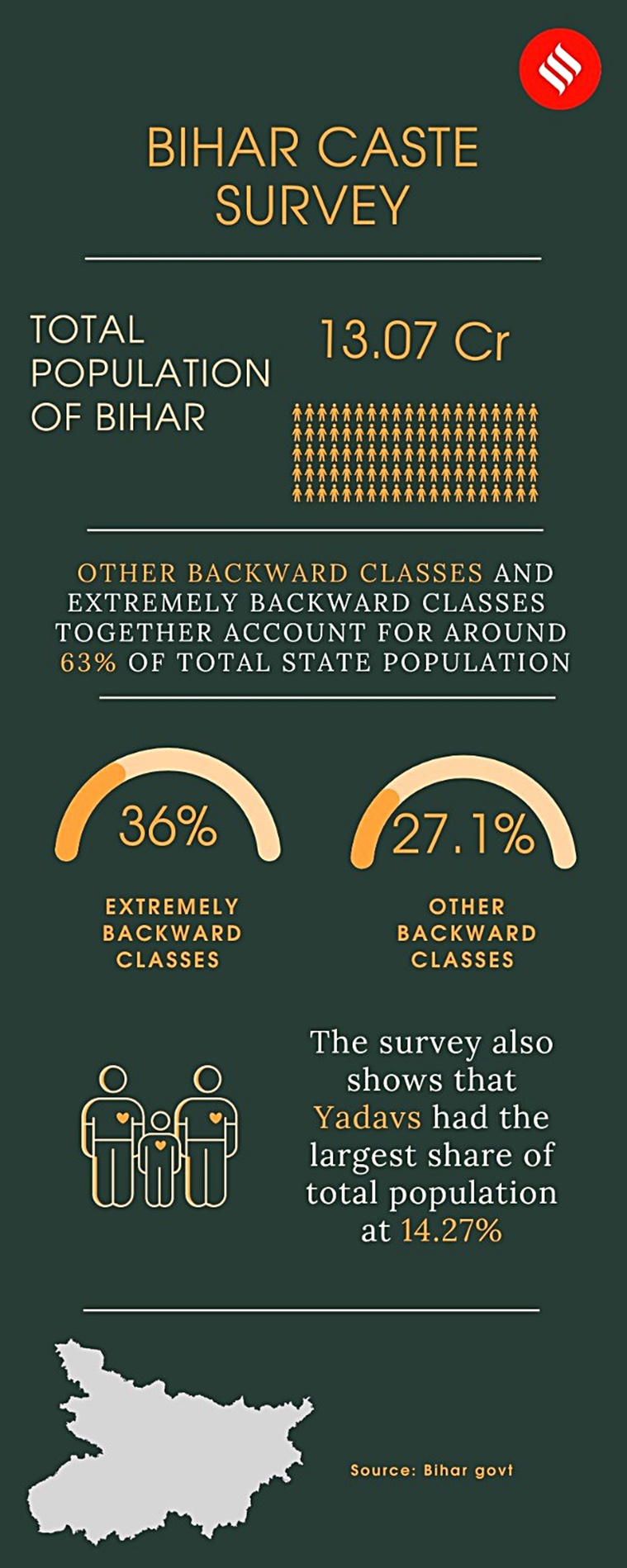AT A TIME when the BJP and Congress are vying with each other for the OBC vote in the coming elections, Bihar Chief Minister and JD(U) supremo Nitish Kumar on Monday stole a march over them.
Choosing Gandhi Jayanti to make the announcement, the Nitish government revealed the results of its caste survey, putting the combined OBC strength in the state at 63% – a 10% leap over their share estimated by the 1931 census, the last time caste enumeration was done in the country – and adding fresh vigour to the Opposition’s demand for a caste census.

It might also cast a shadow over the Modi government’s achievement in passing the law to reserve seats for women in state Assemblies and the Lok Sabha, as the Opposition calls this incomplete without an OBC quota within the 33%.
The Bihar government conducted the caste survey over two phases, after it had to be discontinued in May this year following a set of PILs. The go-ahead finally came in August.
According to data released by Development Commissioner Vivek Singh, Bihar’s total population now stands at a little over 13.07 crore, up from 10-odd crore in the 2011 Census. The EBCs make up 36.01% of this, and OBCs an additional 27.13%. The survey also found that Yadavs, the main vote base of the RJD, are the largest group, accounting for 14.27% of the total population.
 Bihar caste survey data
Bihar caste survey data
The Dalits, or Scheduled Castes, account for 19.65%, higher than expected, while STs comprise 1.68%.
Those belonging to the “unreserved” category, or the “upper castes”, who dominated politics till the Mandal wave of 1990s, comprise 15.52% of the total population. These groups, who are believed to be BJP voters, are 2-3% more in number than the general opinion regarding their numbers.
Story continues below this ad
The Muslims, the second leg of the RJD’s M-Y plank, comprise 17.70% of the population. The other religious minorities have a minuscule presence.
Lauding the government officials who undertook the exercise, CM Nitish Kumar said Monday, “A meeting will soon be convened of all the nine political parties with an electoral presence in the state legislature, and the facts and figures will be shared with them.”
Nitish’s ally and RJD president Lalu Prasad said the exercise will set the tone for “a nationwide caste census which will be undertaken when we form the next government at the Centre”.
The BJP, which has been on the horns of a dilemma over the issue, given its potency in Bihar, argued that the survey did not give an idea of “the changed social and economic realities” over the years. State BJP president Samrat Choudhary said that while his party had “given its consent” for the exercise, it would make an assessment of the findings.
Story continues below this ad
It was in February 2020 that Nitish first came up with the decision to conduct a caste survey. A resolution was moved in the Assembly, with no party daring to oppose the move in a state where caste dictates politics, including the BJP. While the BJP at the Centre was opposed to a caste census, its state unit voted along with the Nitish government in the Assembly, leading to a unanimous resolution.
Then, in August 2021, the Bihar CM led a 10-party delegation, including the state BJP, to meet Prime Minister Narendra Modi and demand a caste census. It was the first hint of political change in the air in Bihar as Nitish chose to share prime space with RJD leader Tejashwi Yadav on the move.
In June 2022, the Nitish government – now a Mahagathbandhan government, led by him – gave the nod to a caste survey, with estimated expenses of Rs 500 crore.
In the Opposition by then, the BJP opposed this, saying the party was not taken into confidence over “modalities of the survey” and over “several sub-castes not being covered”.
Story continues below this ad
However, the huge population of EBCs in the state, seen as floating voters wooed by all parties, meant the Bihar BJP didn’t press the matter.
The survey finally started on January 7 this year.
In May this year, while the survey was midway through its last phase, a set of five PILs were filed challenging it, as a violation of privacy and on the argument that only the Centre had the authority to conduct a “census”. The matter went to the Supreme Court, which asked the Patna High Court to look into the matter in July.
The High Court finally upheld the survey in August, finding the “action of the state to be perfectly valid, initiated with due competence, with the legitimate aim of providing development with justice”. The state government, which argued that it was conducting a “survey” and not a “census”, completed the exercise by mid-September.
A section of the BJP leaders still doubted that the Nitish government would reveal the survey report, given the expected political fallout. However, as things stand, amidst a new focus on OBCs, the JD(U) chief has little to lose and everything to gain.
Story continues below this ad
For all practical and political purposes, the Bihar caste survey has revived not just Nitish’s politics but also of fellow socialist parties like the RJD.
Plus, given an impetus to the demand for a relook at the OBC quota.



 Bihar caste survey data
Bihar caste survey data





